Hot tubs are the epitome of relaxation, and there’s no better way to recover after a long day than under its warm, bubbling surface.
A key part of ensuring your hot tub remains welcoming and enjoyable is maintaining the quality of your water.
While this includes a few important elements, the pH level is easily one of the most important ones.
Knowing how to balance pH levels in your hot tub is crucial, keeping your water quality in check to ensure a safe environment while ensuring your spa stays in pristine condition.
And we’re going to give you all the knowledge you need to master your spa’s pH levels in this article!
Understanding pH Levels
Before we can jump into how you balance pH levels, it’s important to get a deeper understanding of why pH levels are so important.
pH shows you how acidic or basic your water is and is measured on a scale of 0 to 14.
Seven marks the neutral point, with levels below that being more acidic, and above signaling more alkaline water.
When it comes to hot tubs, the magic number for pH levels is between 7.2 and 7.8.
Why Maintaining the Right pH Levels is Crucial
The water in your hot tub comes into contact with every part of your spa, from the shell, through your pipes, in your pump, around your heating element, and out of the jets.
This means that improperly balanced water can have a negative impact on the entire system of your hot tub!
Not only that, but it can also create an unsafe environment for you to be soaking in.
What Happens if Your pH Is Too High?
If your pH is above 7.8, your water has become too alkaline, or “basic.”
Soaking in water that’s too alkaline can cause your eyes and skin to feel itchy and irritated, and reduces the effectiveness of your sanitizer, increasing the risk of bacteria forming in your water.
When it comes to your system, high pH levels can result in hard scale forming on your pipes, heating element, shell and around your jets.
Over time, this can lead to reduced performance and efficiency, not only reducing the flow of water through your system but also impacting how well your heater works!
What Happens if Your pH Is Too Low?
If your pH drops below 7.2, it’s become too acidic, which is corrosive to your system.
If this happens too often or is left improperly balanced for extended periods of time, you may discover various parts of your spa slowly being eaten away from the acidity of the water.
Furthermore, acidic water becomes unsafe to be in, resulting in red, itchy eyes, and could even cause skin rashes!
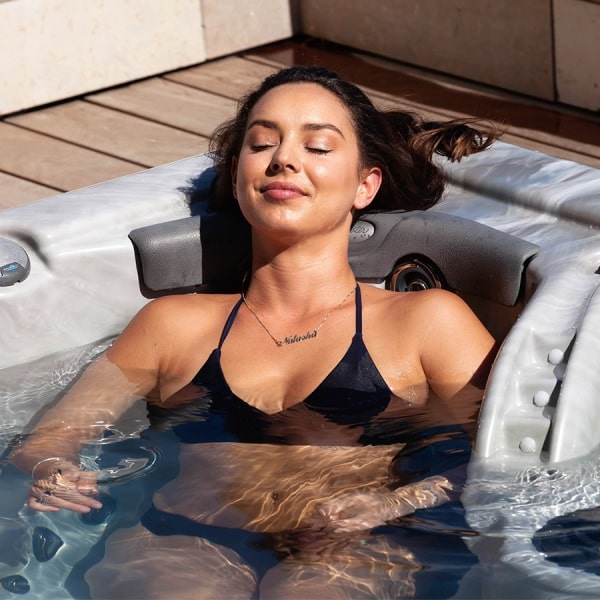
5 Common Factors Affecting pH Levels in Hot Tubs
At this point, you may be wondering what exactly causes your pH levels to fluctuate, and this can happen in a variety of ways.
Most often, it comes down to contaminants entering your spa, changing the quality of your water.
1. The Quality of Your Water
Before any additional elements contaminate your water, it’ll have a base quality.
Local water quality changes based on location, and can vary by several points across your entire state.
The base quality of your water will influence how you have to treat it to bring your pH levels into the best range of your hot tub, as mentioned above.
2. How Often Your Hot Tub is Used
After you’ve balanced your water’s pH and alkalinity, any additive can influence those levels.
One of the most significant aspects that can change your pH levels is the frequency of use.
Each time you use your spa, various organic matter enters the water. This can be things like:
- Dead skin cells
- Body lotion
- Deodorant
- Detergent on your swimsuit
- Hair product
Essentially, anything on your body or swimsuit can be stripped off into the water, changing the pH levels you previously measured.
3. How Many People Use Your Hot Tub
Similarly, the number of people using your spa will also have an influence on how quickly you can expect your pH levels to move.
More bodies mean an increase of organic matter entering the water, changing your pH levels more drastically.
This makes it extra important to check your pH levels and readjust them following any heavy use, such as after a hot tub party or weekend gathering of loved ones.
4. Additional Treatment Products
To maintain the overall quality of your hot tub water, you’ll also need to add some additional products.
This could include things like:
- Sanitizer
- Shock
- Alkalinity increaser
- Calcium hardness increaser
- Water softener
While a mixture of products will be needed to keep your water healthy and safe, each time you add a dose to your spa, your pH levels will be affected.
5. Environmental Factors
While your hot tub cover should always be protecting your hot tub water anytime you’re not in its warm depths, this factor still comes into play.
Each time you’re enjoying a relaxing soak, your water is exposed to the elements and, therefore, susceptible to their influence.
This can include things like snow, rain, dirt, and various other debris.
Each of these aspects has an effect on your pH levels, especially snow and rain, which increase the amount of untreated water entering your spa.
Water Treatment Products to Balance pH Levels
Adjusting your pH levels is quite simple, and can be done with just a couple of basic spa chemicals:
- pH increaser
- pH decreaser
Apart from these essential products, there are two other products that can be helpful based on your local water quality; calcium hardness increaser or water softener.
These chemicals would only be added to your spa after a water change, and aim to combat the base state of your water, bringing it into a more manageable range.
Essentially, these additives can help make balancing your water easier.
Calcium hardness increaser is great if you have soft (acidic) water, while water softener can help bring your pH levels down if you live somewhere with harder (more alkaline) water.
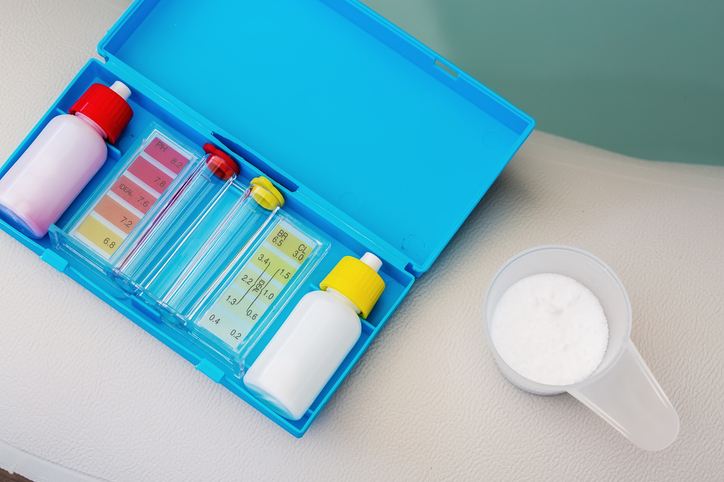
Your Step By Step Guide to Balance pH Levels in Your Hot Tub
To balance pH levels, there are a few essential steps to ensure the process is as easy (and effective) as possible.
Step 1: Test Your Water
Before you can begin treating your water to balance your pH levels, you’ll need to know your starting point.
You can determine this by testing your water with a pH test strip, or water test kit.
This test will give you a variety of information about your water quality, such as:
- pH
- Alkalinity
- Sanitizer
Some pH test strips also provide information on the calcium hardness of your water, which can be a helpful bit of information when you’re testing and treating your water after a water change.
Your pH levels can change quickly, so it’s important to do this step two to three times a week.
This helps ensure you catch changes quickly, and rebalance your water when the need arises, minimizing the risk of imbalanced water damaging your system.
Step 2: Balance Your Alkalinity
After testing your water, you’ll want to bring your alkalinity levels within the proper range before moving on to your pH.
The alkalinity of your water helps to maintain your pH levels, reducing their ability to rise and fall outside their expected range.
For this reason, alkalinity products have a significant impact on the fluctuation of your pH levels, making it crucial to adjust them first.
The ideal alkalinity level for hot tubs is between 80 and 120 ppm. If it’s below 80 ppm, you can use an alkalinity increaser (or baking soda) to boost the levels up, or your pH decreaser if its level is above 120 ppm.
Note: Keep your jets on low when adding your treatment products to ensure they are evenly dispersed.
Additionally, when adding any treatment products to your water, ensure you add small doses at a time, following the directions on the container closely to avoid adding too much.
While you can always add more if needed, you can’t remove your chemicals once they’re added!
Step 3: Balance Your pH
After adjusting your alkalinity, you can begin focusing on your pH levels.
To bring them within their safe range (7.2 – 7.8), you can use your pH increaser or pH decreaser.
After adding the appropriate amount of product, let your jets run for 20 minutes. This helps ensure they completely mix into your water and have a chance to begin working.
After 20 minutes, re-test your water to see if your pH and alkalinity have been effectively brought into balance.
Once they’re in range, you can move on to managing your sanitizer levels!
Top Signs Your pH is Imbalanced
Your water is one of the first ways your spa will communicate issues to you, and when your pH isn’t balanced, it can take a few unsightly forms!
Cloudy Water
One of the most common signs of improperly balanced water is a sudden cloudy or murky appearance.
If you’ve lifted your cover and your water is no longer crystal clear, you’ll want to hang up your towel and test your water’s pH levels.
A Foamy Surface
Remember when we said that organic matter, like hair products and detergents, can affect your pH levels?
Foam is one of the most recognizable signs of an overload of organic matter!
While fluffy bubbles are great in a bath, they have no place in a hot tub and will need to be cleared up before your next soak.
Foul Smelling Water
Your hot tub water should never smell bad, not even like strong chlorine. If you’ve lifted your cover and been hit with a foul odor, you’ll want to bust out your pH test strips and get a reading on your water quality!
While this can certainly be the result of improper sanitizer levels, it’s also a telltale sign of unbalanced pH levels.
Scale or Corrosion
Another clear indication that your pH levels have been improperly balanced is scale or corrosion developing on various parts of your system.
This will happen over time but will develop much faster if your water is too acidic or basic more frequently or for long periods of time.
There are three main areas you’ll first notice corrosion or scale buildup:
- On the shell
- Around the Jets
- On the heating element
Tips To Maintain Your pH Levels
Clearly, keeping your spa water in tip-top shape is an important aspect of hot tub ownership, and luckily there are ways you can help reduce the rate at which your pH levels change.
- Stick to a maintenance routine
- Drain and clean your spa every 3-4 months
- Regularly test your water
- Rinse off before you use your spa
- Pre-filter your water with a garden hose filter attachment
- Avoid overtreating your water
- Consider a water softener or calcium hardness increaser based on your local water quality
Each one of these steps can help reduce the amount of contamination your spa is exposed to, and keep your water cleaner.
Not only will this help keep your pH levels in balance, but they can also reduce the amount of chemicals you need to add to your water, and make your routine maintenance much easier.
Hot Tubs and Spa Maintenance in Chelan
Are you having a hard time balancing your pH levels? Heading out on a vacation and need someone to step in to maintain your water quality while you’re away?
At Swim World, our team of experts are here to help with all your hot tub maintenance needs! Whether it’s balancing your pH levels, diagnosing and making repairs, or draining and refilling your spa, we do it all!
Contact us today or request service using our online form, and we’ll be in touch with you shortly.

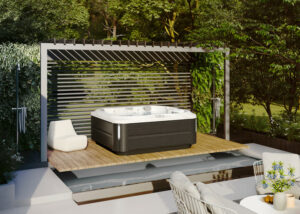
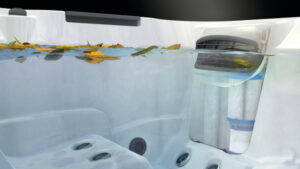
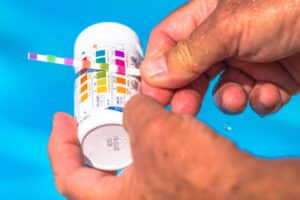
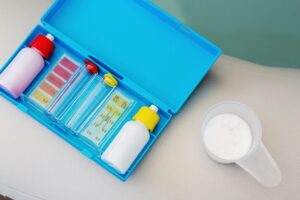
 by
by 